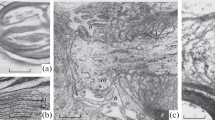Summary
Structural and functional behaviour of motor end-plates after transection of the motor nerve has been studied in two species of frog: Rana esculenta and Rana temporaria. The physiological results show that in both species there is a transient cessation of spontaneous activity followed by a resumption of miniature end-plate potentials (min. e.p.p.s.) after denervation. The characteristics of these potentials (frequency, distribution of amplitudes, time-course) are similar in the two species. However, some differences have been observed: Firstly, the period of silence lasts for 2–4 days in the case of Rana temporaria whereas it is prolonged to about 15 days in Rana esculenta. Secondly, the resumption of min. e.p.p.s. is gradual and after the 10th day of denervation remains constant in Rana temporaria. It is inconstant independent of the period of denervation in Rana esculenta. The morphological results show that the Schwann cell is constantly in contact with the post-synaptic membrane after about 6 days of denervation in both species. It is suggested that either the Schwann cell is capable of functioning for a limited period of time in Rana esculenta or is activated to produce min. e.p.p.s. only in certain cases.
Similar content being viewed by others
References
Bevan, S., Miledi, R., Grampp, W.: Induced transmitter release from Schwann cells and its supression by actinomycin D. Nature (Lond.) New Biol. 241, 85–86 (1973)
Birks, R., Huxley, H.E., Katz, B.: The fine structure of the neuromuscular junction of the frog. J. Physiol. (Lond.) 150, 134–144 (1960 a)
Birks, R., Katz, B., Miledi, R.: Physiological and structural changes at the amphibian myoneural junction, in the course of nerve degeneration. J. Physiol. (Lond.) 150, 145–168 (1960 b)
Couteaux, R., Pécot-Dechavassine, M.: Particularités structurales du sarcoplasme sous-neural. C.R. Acad. Sci. (Paris) 266, 8–10 (1968)
Couteaux, R., Pécot-Dechavassine, M.: Vésicules synaptiques et poches au niveau des “zones actives” de la jonction neuromusculaire. C.R. Acad. Sci. (Paris) 271, 2346–2349 (1970)
Couteaux, R., Pécot-Dechavassine, M.: Données ultrastructurales et cytochimiques sur le mécanisme de libération de l'acétylcholine dans la transmission synaptique. Arch. ital. Biol. III, 231–262 (1973)
Couteaux, R., Pécot-Dechavassine, M.: Les zones spécialisées des membranes présynaptiques. C.R. Acad. Sci. (Paris) 278, 291–293 (1974)
Dreyer, F., Peper, K., Akert, K., Sandri, C., Moor, H.: Ultrastructure of the “active zone” in the frog neuromuscular junction. Brain Res. 62, 373–380 (1973)
Fukami, Y., Ridge, R.M.A.P.: Electrophysiological and morphological changes at extrafusal endplates in the snake following chronic denervation. Brain Res. 29, 139–145 (1971)
Hunt, C.C., Nelson, P.G.: Structure and functional changes in the frog sympathetic ganglion following cutting of the presynaptic nerve fibres. J. Physiol. (Lond.) 177, 1–20 (1965)
Katz, B., Miledi, R.: Spontaneous subthreshold activity at denervated amphibian end-plates. J. Physiol. (Lond.) 146, 44–45 (1959)
Miledi, R., Slater, C.R.: Electrophysiology and electron microscopy of rat neuromuscular junctions after nerve degeneration. Proc. roy. Soc. B 169, 289–306 (1968)
Miledi, R., Slater, C.R.: On the degeneration of rat neuromuscular junctions after nerve section. J. Physiol. (Lond). 207, 507–528 (1970)
Winlow, W., Usherwood, P.N.R.: Ultrastructural studies of normal and degenerating mouse neuromuscular junctions. J. Neurocytol. 4, 377–394 (1975)
Winlow, W., Usherwood, P.N.R.: Electrophysiological studies of normal and degenerating mouse neuromuscular junctions. Brain Res. 110, 447–462 (1976)
Author information
Authors and Affiliations
Rights and permissions
About this article
Cite this article
Verma, V., Pécot-Dechavassine, M. A comparative study of physiological and structural changes at the myoneural junction in two species of frog after transection of the motor nerve. Cell Tissue Res. 185, 451–464 (1977). https://doi.org/10.1007/BF00220650
Accepted:
Issue Date:
DOI: https://doi.org/10.1007/BF00220650




